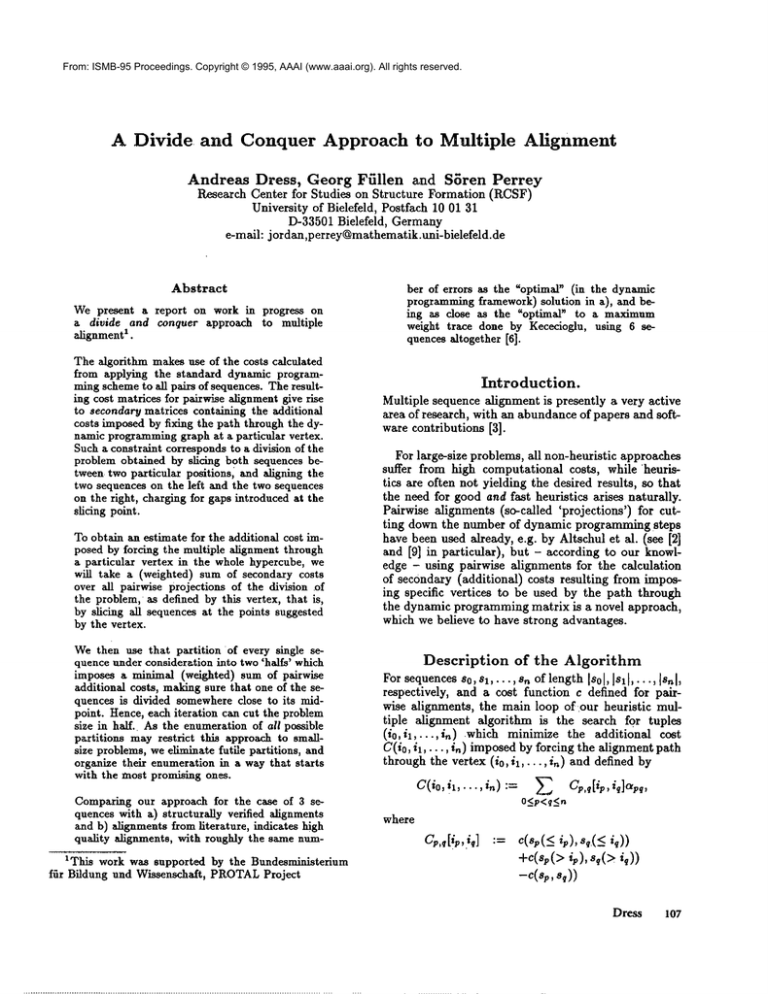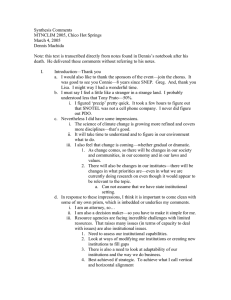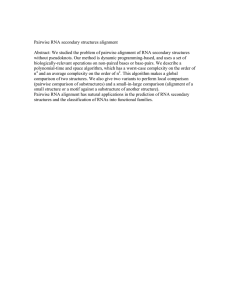
From: ISMB-95 Proceedings. Copyright © 1995, AAAI (www.aaai.org). All rights reserved.
A Divide¯
and Conquer Approach to Multiple
Andreas
Dress,
Georg Ffillen
wud SSren
Perrey
Research
Center for Studies on Structure Formation
University of Bielefeld, Postfach 10 01 31
D-33501 Bielefeld,
Germany
e-marl: jordan,perrey@mathematik.uni-bielefeld.de
Abstract
We present a report on work in progress on
a divide and conquer approazh to multiple
a.alignment
The algorithm makes use of the costs calculated
from applying the standard dynamic programming scheme to all pairs of sequences. The resulting cost matrices for pairwise alignment give rise
to secondary matrices containing the additional
costs imposed by fixing the path through the dynamic programming graph at a particular vertex.
Such a constraint corresponds to a division of the
problem obtained by slicing both sequences between two particular positions, and aligning the
two sequences on the left and the two sequences
on the right, charging for gaps introduced at the
slicing point.
To obtain an estimate for the additional cost imposed by forcing the multiple alignment through
a particular
vertex in the whole hypercube, we
wiU take a (weighted) sum of secondaxy costs
over all palrwise projections of the division of
the problem, as defined by this vertex, that is,
by slicing all sequences at the points suggested
by the vertex.
We then use that partition of every single sequence under consideration into two ’halLs’ which
imposes a minimal (weighted) sum of pairwise
additional costs, making sure that one of the sequences is divided somewhere dose to its midpoint. Hence, each iteration can cut the problem
size in half. As the enumeration of all possible
partitions may restrict this approach to smallsize problems, we eliminate futile partitions, and
organize their enumeration in a way that starts
with the most promising ones.
ffir
1This work was supported by the Bundesrnlnlnterium
Bildung and Wissensehaft, PROTALProject
(RCSF)
bet of errors as the "optimal" (in the dynamic
programming framework) solution in a), and being as close as the "optimal" to a maximum
weight trace done by Kececioglu, using 6 sequences altogether [6].
Introduction.
Multiple sequence alignment is presently a very active
area of research, with an abundance of papers and software contributions [3].
For large-size problems, all non-heuristic approaches
suffer from high computational costs, while ’heuristics are often not yielding the desired results, so that
the need for good and fast heuristics arises naturally.
Pairwise alignments (so-called ’projections’)
for cutting down the number of dynamic programmingsteps
have been used already, e.g. by Altschul et al. (see [2]
and [9] in particular), but - according to our knowledge - using pairwise alignments for the calculation
of secondary (additional) costs resulting from imposing specific vertices to be used by the path through
the dynamicprogrammingmatrix is a novel approach,
which we believe
to have strong
Description
advantages.
of the Algorithm
For sequences so, Sl,..., sn of length Is01,IsxI,..., Isnl,
respectively,
and a cost function c defined for pairwise alignments, the main loop of our heuristic
multiple alignment algorithm is the search for tuples
(io,it,...,in)
.which minimize the additional
cost
C(io, it,...,
in) imposed by forcing the alignment path
through the vertex (io, it,...,
in) and defined by
C(io, it,...,
Comparing our approach for the case of 3 sequences with a) structurally verified alignments
and b) alignments from literature, indicates high
quality alignments, with roughly the same num-
Alignment
in) := ~ Cp.q[iv,
i~]oq,
q,
O<_v<q<_n
where
Cv,,[iv,.i,]
:= c(sp(<_ in) ,sq(< i~))
+e(sv(>/p),
s,(>
-c(sv,,q))
Dress
107
are the additional costs imposed on the pairwise alignment of sequences sv and sq and avq > 0 are appropriately chosen weight factors reflecting e.g. phylogenetic
relationships. Here, the notation sv(< iv) denotes the
subsequence of sv with indices running from 0 to iv
and sv(> ip) denotes the subsequence starting at site
ip+l.
The result of
"minimal" tuple.
then recursively
(sk(< ik))k=O,...,n
the minimum search is called the
Given such a tuple, the algorithm
solves the 2 subproblems of aligning
and (sk(> ik))k=o .....
Several techniques can be employed to cut down the
number of tuples considered:
1. The index i0 is fixed to be rls0 I/2]. This is problematic only if a particular part of the a priori optimal
alignment has gaps on both sides of the index i0 in
the sequence so, because any gap insertion below i0
will then be charged twice (i.e. in both subproblems).
Readjusting the final alignment in the proximity of
gaps should at least reduce the problem.
2. While searching for the "minimum" tuple, if
some part of the sum ~o<_~<q<_nCp,~[ip,iq]~pq,
e.g. Coj[r, s]apq is larger than the minimumfound
so far, no tuples (i0, Q, is,..., in) with corresponding indices (e.g. (r, s, is,..., in)) will be considered.
3. The exploration of "tuple space" {(i0,..., in) I iv
{0,..., Isp[}} starts in the middle of the sequences,
and gradually traverses back and forth towards the
endp0ints. This way, it is very easy to cut the exploration process at any time, and be confident that
the most promising tuples have been explored, if the
a priori alignment is "regular", i.e. does not contain
too many unequally distributed
gaps. We can expect that we obtain inferior results if the sequences
are of very different length, or are not homologous.
Table 1 displays the Algorithm Flowchart for the case
n = 3, and apq := 1.
Implementation Notes
1. The classic dynamic programming similarity matrices are obtained using the Toplign package developed
by [7]. Weuse the Dayhoff PAM250matrix to calculate the amino acid substitution costs, and we charge
13 units for a gap-insertion, and 1 unit for any gap
extension.
2. If all of the sequences in a subproblem have length
less than minLength (typically 3), the recursion
stopped, and an optimal alignment algorithm by
Huang [5] is called in a black-box manner. This is
merely a convenience, since each call to the Toplign
package currently involves re-reading the (Dayhoff)
matrix via the file system.
108
ISMB-95
First Results
Our alignment algorithm has been subjected to a few
test cases, with all weight factors being put to 1. On
average, our algorithm needed to explore ca. 1~ of all
possibilities to find the best second and third index
(whereas the first index is always fixed to one half the
length of the first sequence). The maximumdeviation
from the starting point in the middle of the sequence
was ca. 15 %during the first step, and ca. 30 % during
the second step. As expected, the longer the subsequence, the smaller the percentage of the tuple space
that needs to be explored. Of course, to evaluate our
method in general, one has to investigate many more
examples.
Fig. 1 gives a comparison between the alignment of
three cytochromes, cytochrome c2 from Rhodospirillnm
rubrum, cytochr0me c2 from Rhodobader capsula~ns,
and cytochrome e from Oryza sativa I.
The alignment obtained by our method is labeled
"Divide and Conquer", and the structurally verified
alignment derived from Lessel and Schomburg (1994)
[8] is labeled "Structurally verified". Also, the MSA
optimal multiple alignment is given, labeled "MSA"
[9]. Finally, the pairwise alignments obtained by using the standard dynamic programming calculation
employed by Topl~gn are labeled "Dynamic programming pairwise alignments!’ (see Implementation Notes,
1). Only the residues marked by %" are indeed part
of the homology. All computed alignments are compared to these homologous residues. Deviations from
this standard-of-truth are markedb~, "[". Finally, the
"Divide and Conquer’-alignment is preceded by a line
"X:" indicating depth and location of the recursive division. For example, the division of the two subproblems during the second step takes place on the right of
the positions marked by arrows in Figure 1.
The number of ’~mistakes" made by our approach is
of the same order as that of the "optimal" alignment.
They may have resulted from incorrect similarity assessment caused by the PAM250matrix (i.e. incorrect
with respect to the structurally verified alignment), or
they may bedue to a misdirection by the secondary
costs at a fairly high recursion level, i.e. during the
treatment of the subproblem to the right at recursion
level 1.
Fig. 2 features the alignment of three blue copper
proteins, viz. pseudoazurin from Alcaligenes faecalis,
plastocyanin green alga (Enterorn. prolifera), and cucumber basic protein. As for Fig. 1, the structurally
verified alignment is derived from [8].
In this case, our algorithm makes almost the same
errors as the MSAmultiple alignment obtained directly by dynamic programming. Shifts by one single
residue (which we do not consider a mistake because
the process of structural alignment typically yields results which may deviate by one position) are marked
by "+’. Again, misalignments made by our method
Table 1. Algorithm Flowchart for the ease n -- 3, and apq := 1.
Alisub(a0, al, a2)
If any sequence length is smaller than a fixed constant minLength,
then (fro, if1, if2) := conventional Alignment(a0,al,
else Calculate secondary cost matrices Cp,q using dynamic progr, matrices
i := [laol/21;eurrMin := oo
Forj :-- [la11/21, flail/2--11, [la11/2+ 11,..., do
If Co,l[i, j] < currMin
For
k:=I’1a21/21,
rla21/211,Fla21/2
+11,...,do
If Co,l[i,j] + C0,z[/, k] + C1,2[j, k] < currMin
Update currMin and save (i, j, k)
(a~o,a’l,a’2) := Alisub(ao(<
i),ai(<
j),a2(< k))
(a~,ai’,a’2’)
j),a,(>
:= Alisub(ao(> i),al(>
(a-0, := (concatenate(aco.cat .ate(= , aT), o ncate ta (
Return(a-0, ffl, of 2)
can already be found in the pairwise alignments ("Dynamic programming pairwise alignments") upon which
our calculations are based.
Fig. 3 compares our approach to results obtained
using "Maximumweight trace" [6]. In this case, the
trace published by Kececioglu is taken as the "standard of truth"; only the first, third, and last sequence
are considered. Using these 3 sequences, our alignment
(Fig. 3) makes ca. 70 "mistakes", all in the neighborhood of gaps. However, the "optimal" approach, labeled again "MSA’,differs from Kececioglu’s result in
about as many positions.
Open Problems,
and Suggestions
Further
Research
for
The following section details someideas for further investigation.
Many more examples need to be investigated.
A windowing approach may be used to correct the
obtained alignments in the proximity of gaps and/or
division points.
In case a heuristic is applied to reduce the number
of tuples to be investigated, the influence of the input
order of the sequences needs to be investigated.
The pairwise projections of our alignment should
be compared to the pairwise alignments provided by
"Toplign’, since the former alignments are based indirectly on the "Toplign" pairwise alignment cost matrices. Moreover, substitution matrices differing from
PAM250(see [4]) should be tested.
1
S.F. Altschul, D.J. Lipman. Trees, Stars and
Multiple Biological Sequence Alignment, SIAM
:l. Appl. Math. 49, 197-209 (1989)
2 H. Carfllo,
D. Lipman. The Multiple
Sequence Alignment Problem in Biology, SIAM
J. Appl. Math. 48, 1073-1082 (1988)
3 S.C. Chan, A.K.C. Wong, D.K.Y. Chiu. A Snrvey of Multiple Sequence Comparison Methods,
Bull. Math. Biol. 54, 563-598 (1992)
4 A. Dress, S. Perrey. Statistics for Fragment Comparison - A Biologically Motivated Approach to
Sequence Alignment, manuscript, submitted for
ISMB 1995
5 Xiaoqiu Huang. Alignment of Three Sequences
in Quadratic Space, Applied Computing Review,
1(2): 7-11 (1993)
6 J.D. Kececioglu. The maximumweight trace problem in multiple sequence alignment. In Proe. of the
4th Symp. on Comb. Pattern Matching, LNCS684,
pp. 106-119 (1993)
7 Th. Lengauer et al. "Toplign" Software Package
(1994)
8 U. Lessel, D. Schomburg. Similarities between 319
Structures. Protein Engineering, Okt/Nov 1994
9 D.3. Lipman, S.F. Altschul, :I.D. Kececioglu. A
tool for multiple sequence alignment. Proc. Natl.
Ac~I. Sci. USA, 86:4412-4415 (1989)
10 S.B. Needleman, C.D. Wunsch. A General
Method Applicable to the Search for Similarities
in the Amino-Acid Sequence of Two Proteins,
J. Molec. Biol. 48, 443-453 (1970)
Dress
1~
~p_.°
i I O~l-.
I,-4 I ~
!i:.
I~ I~ ~ 41
I I
d,
~.
oiil
ii
o;I
h,.II,-i,lP
~: ~,~-
~
¯
~:
~.~.:
H~ ll))
i!,
°i"
I:_--!li
ole
~"
~: °°..~
~.
~"
~: ~: ~:
~i
o.o.~:
~lO~l
-rl
ill
¢1
~)
Ill
.1-1
I-t
I!1
~:
@
0
0
I.i
g
-1-1
@
’I1
.i,4
...4
1 lo ISMB-95
"~
qM
~ ~:
I1
.I)
I:1
4)
: ~:
l
E:
~
1!
I~~ ~’:
~:
Dress
l 11
0
¯ ~
¯ ’,’4 -,’4
112
ISMB-95
Dress
113




